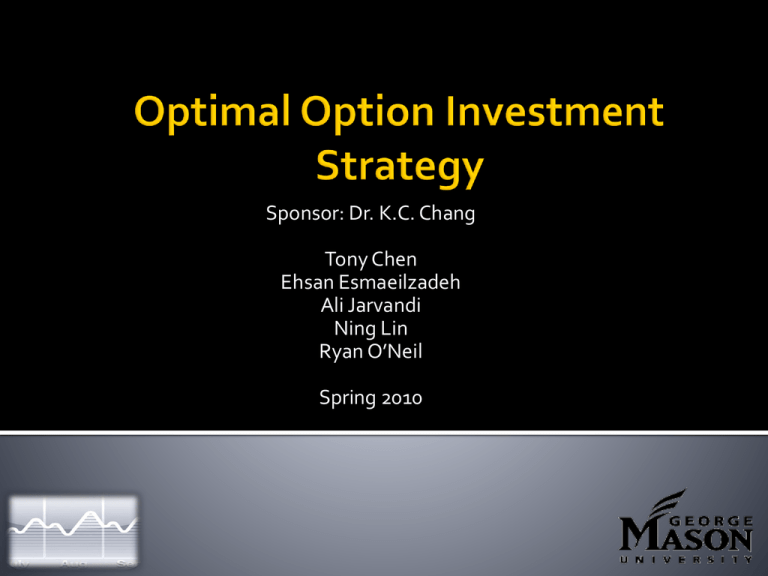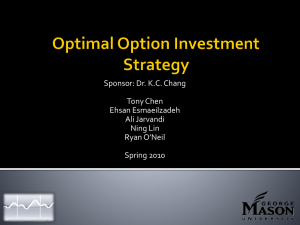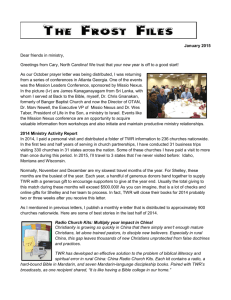Sponsor: Dr. K.C. Chang Tony Chen Ehsan Esmaeilzadeh Ali Jarvandi
advertisement

Sponsor: Dr. K.C. Chang Tony Chen Ehsan Esmaeilzadeh Ali Jarvandi Ning Lin Ryan O’Neil Spring 2010 Background & Problem Statement Project Scope Requirements Assumptions Approach Methodology Modeling Analysis Evaluation & Recommendations Conclusion & Future Work Investors can potentially earn huge profits by trading assets Many investors trade on speculation and attempt to predict the market Options allow investors to trade with greater leverage Option Contract – A conditional futures contract to trade an asset at a given price and date. Option buyer gets right to exercise contract. Positions – Long (buyer) and short (seller) Expiration date –date underlying assets are traded Strike price – Price the commodities are traded Premium – Option price Two general types: call (right to buy) and put (right to sell) American and European Short Strangle Strategy: Simultaneously selling a call and a put with the same expiration date Typically call strike price > commodity price and put strike price is < commodity price SP500 Index, Strangle Put=1100, call=1120 1125 1120 1115 Asset Price 1110 Close 1105 call strike put strike 1100 1095 1090 1085 11/13/2009 11/18/2009 11/23/2009 11/28/2009 12/3/2009 Date 12/8/2009 12/13/2009 12/18/2009 12/23/2009 Call: Commodity price less than strike price Put: Commodity price greater than strike price Payoffs Put=1100, call=1120 100 90 80 Payoff 70 60 50 40 30 20 10 0 1080 1090 1100 1110 1120 1130 Asset Price at Expiration 1140 1150 1160 Stop Loss – Maximum amount seller is willing to lose. Executed by buying back the same option Premium Prices for Put=1100, stop loss=5 45 40 35 Premium Prices 30 25 put premium 20 put stop loss 15 10 5 0 11/13/2009 11/18/2009 11/23/2009 11/28/2009 12/3/2009 Date 12/8/2009 12/13/2009 12/18/2009 12/23/2009 Implied Volatility of Call Options on 12/31/09 Expiring on 1/2010 Implied Volatility 0.33 0.28 0.23 0.18 0.13 975 1025 1075 1125 1175 1225 Strike Price Volatility smile results from variation in implied volatility among options that vary only on premium value. 1275 This project is a continuation of Fall 2009 project Estimated premiums using Black-Scholes model Estimated return using strike prices, stop-loss, and days before expiration as input Previous group used fixed implied volatility. Due to volatility smile, this results in inaccurate premiums. Tradeoffs between profits and risk of ruin need to be balanced using a equity allocation and risk management methods. No easily accessible tools to quickly assess strangle strategy performance. To provide policy recommendations for the option sellers to balance profit and risk of loss using historical data To determine the optimal fraction for investment with associated risk of ruin To develop a graphical user interface to provide useful information investors can act on. Our model and tools can aid fund managers to quickly assimilate information about the current options market conditions We provide a software tool to display equity curves over a specified period of time. Our tool also shows payoffs from fractional investment allocations to match returns and risk of ruin to customer demand Background & Problem Statement Project Scope Requirements Assumptions Approach Methodology Modeling Analysis Evaluation & Recommendations Conclusion & Future Work • • • • • • • Range of data: 2004-2009 Underlying asset is S&P 500 future index Short strangle strategies only Call strike prices +5 to +50 Put strike prices -5 to -50 Stop loss from 5 to 45 and without limit Maximum acceptable volatility at 30, 40, 50 and without limit Strategies missing more than 50% of data points (months) are ignored Only have closing price data so trade after market Our trades do not affect the market Do not simulate trading slippage (always a willing trade partner) Do not consider interest rate or inflation (time value of money) Provide recommendations on investment strategies recommendations are based on expected return on investment and risk of ruin Provide a range of optimal strategies that trade off risk and return according to investors’ risk tolerances Develop a Graphical User Interface (GUI) to display results, statistics, and visual representation of selected strategies Take filtering criteria from users in the model interface Plot the return (equity curve) for various fractional allocations of capital Research relevant papers and previous work Parse and organize the historical data Develop the trading model Validate model & analyze results Determine optimal strategies Develop graphical user interface Background & Problem Statement Project Scope Requirements Assumptions Approach Methodology Modeling Analysis Evaluation & Recommendations Conclusion & Future Work Fractional Investment: choosing investment size by fraction of equity Optimal f: fractional investment which brings the highest return Relevant research: Kelly Formula Vince Formula Initialization Evaluate all strategies and fractions Decide the investment amount Decide the number of contracts Calculate the investment amount for next trade Select the best TWR and the corresponding fraction in the array Definition: Ruin is the state of losing a significant portion (often set at 50%) of your original equity Futures Formula: Where ▪ a = mean rate of return ▪ d = standard deviation of the rate ▪ z = how we define ruin. Here is 50%. TWR of 20th trade and the corresponding risks of ruin 1.1 0.6 1.08 0.5 TWR 0.4 1.04 0.3 1.02 0.2 1 0.1 0.98 0.96 0 0.1 0.15 0.2 0.25 0.3 0.35 0.4 0.45 0.5 0.55 0.6 0.65 0.7 0.75 0.8 0.85 0.9 0.95 Fraction 1 Risk of Ruin 1.06 Background & Problem Statement Project Scope Requirements Assumptions Approach Methodology Modeling Analysis Evaluation & Recommendations Conclusion & Future Work Optimization Model • Days before expiration • Put & Call strike prices • Stop loss • Maximum volatility • Average return • Final TWR • Maximum Draw-Down • Optimal Fraction • Risk of Ruin GUI Application Background & Problem Statement Project Scope Requirements Assumptions Approach Methodology Modeling Analysis Evaluation & Recommendations Conclusion & Future Work Terminal Wealth Relative (TWR) – 𝐹𝑖𝑛𝑎𝑙 𝐴𝑐𝑐𝑜𝑢𝑛𝑡 𝐼𝑛𝑖𝑡𝑖𝑎𝑙 𝐴𝑐𝑐𝑜𝑢𝑛𝑡 Average percent return – mean of monthly returns Maximum drawdown – greatest negative difference between two dates over a time period 80 70 Average final TWR 60 50 40 30 20 10 0 60 59 58 57 56 53 52 51 50 49 46 45 44 43 42 39 38 37 36 35 32 Days Before expiration 31 30 29 28 25 24 23 22 21 18 17 16 15 Average Final TWR 2008 Average Final TWR 2009 9 9 8 8 8 7 7 7 6 6 6 5 4 Average Final TWR 9 Average Final TWR Average Final TWR Average Final TWR 2007 5 4 5 4 3 3 3 2 2 2 1 1 1 0 0 60 58 56 52 50 46 44 42 38 36 32 30 28 24 22 18 16 Days Before Expiration 0 60 58 56 52 50 46 44 42 38 36 32 30 28 24 22 18 16 Days Before Expiration 60 58 56 52 50 464442 38 36 32 30 282422 18 16 Days Before Expiration Stop-Loss 10 250 Average Final TWR Average Final TWR 250 200 150 100 50 0 200 150 100 50 0 60 58 56 52 50 46 44 42 38 36 32 30 28 24 22 18 16 60 58 56 52 50 46 44 42 38 36 32 30 28 24 22 18 16 Days Before Expiration Days Before Expiration Stop-Loss 30 250 Average Final TWR Average Final TWR 250 Stop-Loss 20 200 150 100 50 0 Stop-Loss 40 200 150 100 50 0 60 58 56 52 50 46 44 42 38 36 32 30 28 24 22 18 16 Days Before Expiration 60 58 56 52 50 46 44 42 38 36 32 30 28 24 22 18 16 Days Before Expiration Day 44 Before Expiration Day 42 Before Expiration Better strategies lie around call = +5 and put = -15 25000 25000 20000 20000 20000 15000 15000 15000 10000 10000 10000 5000 5000 5000 0 0 0 Number of Strategies 25000 Max. Vix = 30 Max. Vix = 50 No Max. Vix Total number of Strategies = 33320 Total number Of Strategies = 34000 Total Number Of Strategies = 34000 Methodology: ▪ Vary parameters of the optimal strategy one at a time Optimal Strategy: ▪ ▪ ▪ ▪ ▪ Call Price = +5 Put Price = -15 Stop-loss = 20 Days before expiration = 42 Fraction allocation = 100% Strategy Output: ▪ ▪ ▪ ▪ ▪ Final TWR = 711 Risk of ruin = 0% Average monthly return = 16% Percent winning trades = 88% Maximum draw-down = 15% Stop-Loss 800 800 700 700 600 600 500 500 Final TWR Final TWR Days Before Expiration 400 300 400 300 200 200 100 100 0 0 60 58 56 52 50 46 44 42 38 36 32 30 28 24 22 18 16 Days Before Expiration 5 10 15 20 25 30 Stop Loss 35 40 45 None Sensitivity Analysis by Put Strike 800 800 700 700 600 600 500 500 Final TWR Final TWR Sensitivity Analysis by Call Strike 400 300 400 300 200 200 100 100 0 0 5 10 15 20 25 30 35 Call Strike Price 40 45 50 -5 -10 -15 -20 -25 -30 -35 Put Strike Price -40 -45 -50 Background & Problem Statement Project Scope Requirements Assumptions Approach Methodology Modeling Analysis Evaluation & Recommendations Conclusion & Future Work Days 39-44 provide the highest return Stop-loss amounts of 15-25 were most common in the top strategies Continuing to trade in high volatility market resulted in higher final return Manageable higher stop-loss values should be chosen rather than low stop-loss values which can be difficult to implement in a volatile market. Fractional investment allocation should also be less than 100% to avoid ruin because the market is constantly moving and therefore the future is still uncertain. It would not be necessarily accurate to use our exact optimal strategies in the future since it may only remain optimal for a short period of time A continuously weighted forecasting model with current data should be used to update optimal strategies Expansion of scope to analyze more complex strategies to yield higher profits Obtaining a more complete and suitable data set especially for earlier years to find better patterns for forecasting the future Addition of adaptive logic so that optimal strategies are calculated using only a portion of data



